
A construction job site can be a pretty chaotic scene. Granted, it’s mostly controlled chaos — but chaos nonetheless. Keeping on top of everything and maintaining a clear picture of the progress is a tall task. The contracts, schedules of values and other documents help provide a general overview of the project and how it should be progressing.
However, the details of how the job is actually progressing lie in the daily construction reports. Read on as we discuss why these reports are not only important but can help speed up the payment process.
What is a daily construction report?
A daily report is pretty much exactly as it sounds. It’s a document that reports the daily activities on a project and is considered by many as one of the more important aspects of successful project management. While the terms and responsibilities outlined in the project contract are of paramount importance, the daily reports are a way to supplement the contract by verifying and documenting the progress.
Construction daily reports explain the details of the site and the job while providing a record to help keep subs and stakeholders informed. They allow everyone to know what happened on the job site, and the project’s current “health status.” Plus, anytime a delay occurs, a daily report will document the circumstances that caused it – so there’s less room for arguing back and forth over the details of what happened.
What information should a daily construction report include?
A solid daily report will include any and all pertinent information collected at the end of each workday. The key here is to be comprehensive. This may include the date and time, weather and site conditions, material and labor logs, potential risks, any incidents onsite, notes and commentary, and more.
Here’s a full list of typical daily log items.
Download the template
Job details

The first page of your daily construction report will always include the job name, location, number, and type. You should also include what phase the project was in that day, such as “groundbreaking” or “rough framing.”
Weather conditions

The weather conditions can always affect a construction project and should be recorded daily. Changes in weather can impact the project timeline — and even create risks for workers. Make sure to write down a description of the general weather conditions including the overall conditions, temperature, amount of precipitation/snowfall, and wind speed.
Work logs and crew timesheets
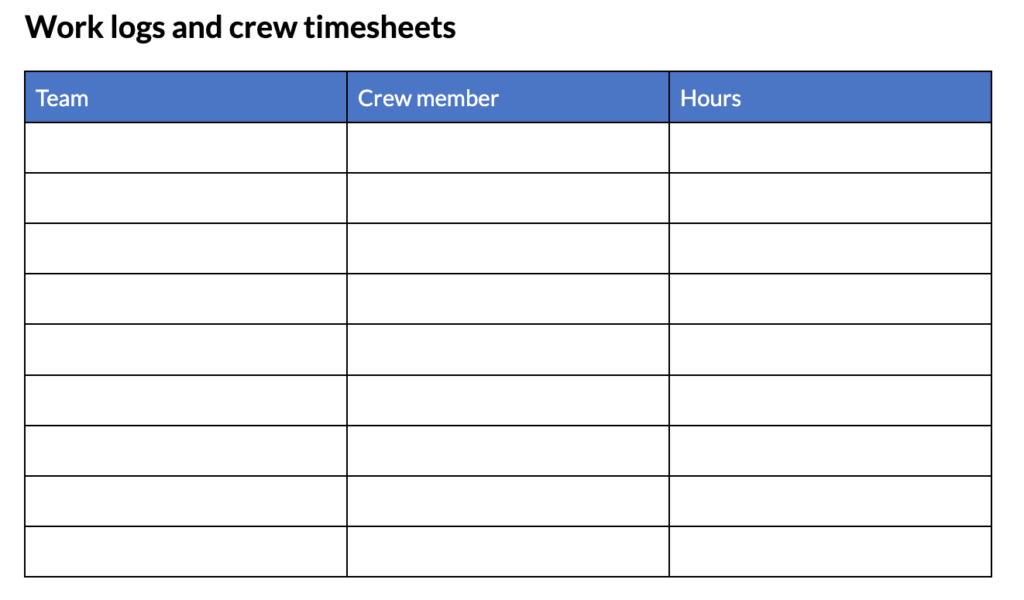
Include everyone who was present on the jobsite that day — and what they worked on. On any project, there may be different workers and entire teams present. Write down which teams were present, the number of workers on each team, and the hours each group logged on each part of a project. You can use this information to calculate the total “manpower” hours completed by a specific crew member, team, or on a part of the project.
Equipment
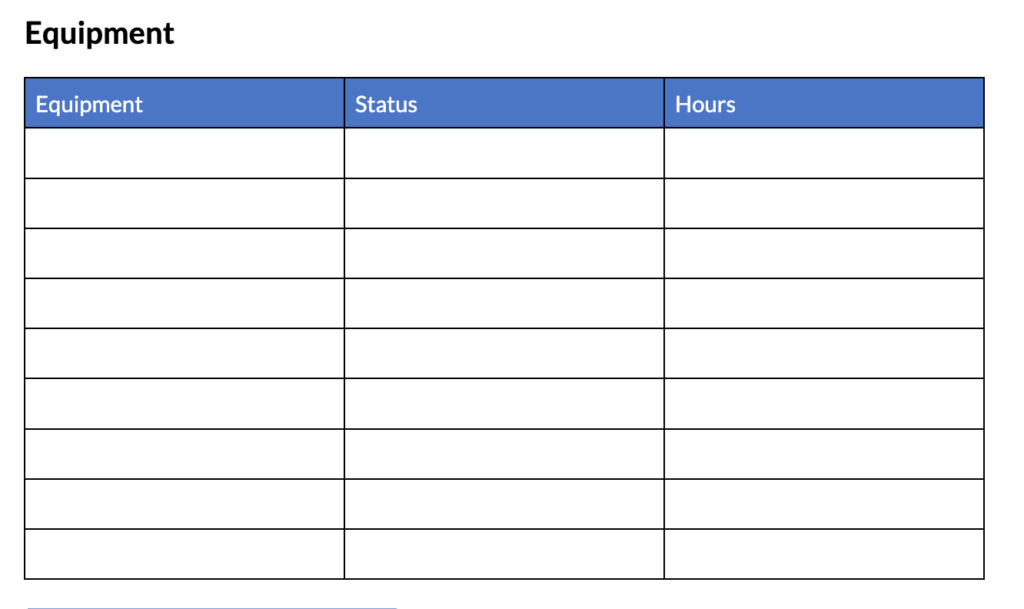
Track and document the work hours of each piece of equipment the same way you would a worker. Every day’s report should include all the equipment present on the site and how much it was used — even if it wasn’t used at all, that should be noted as well. Noting times pieces of equipment are left idle can help them be rented more efficiently in the future. Be sure to also include any time a piece of equipment is brought to or leaves the jobsite.
Materials
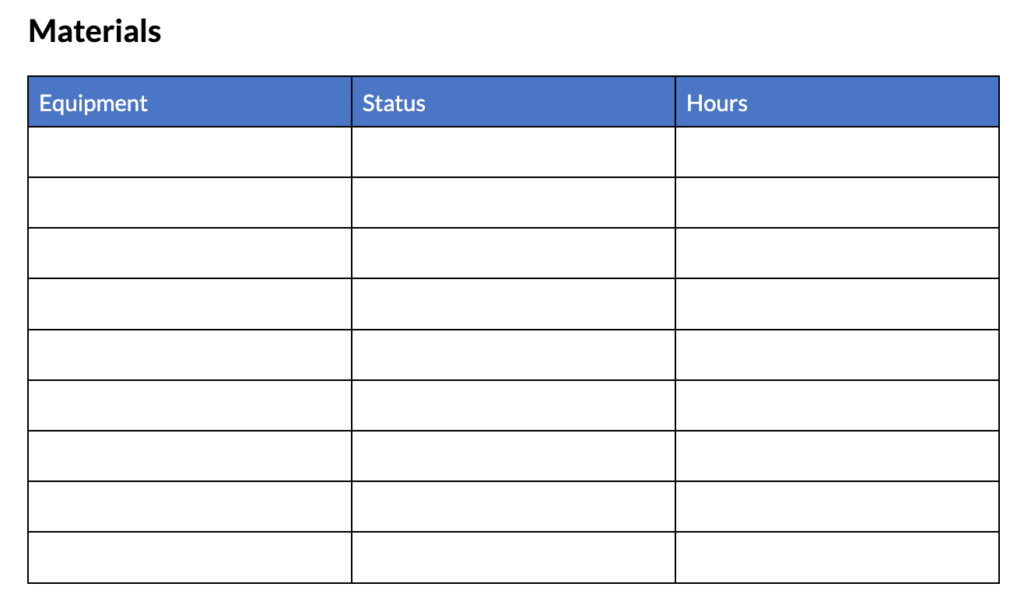
Include a daily inventory of any and all materials on the site and used during the day. By tracking material quantities and keeping track of how many remain, you can gain insight on how much work was performed that day using a specific material.
Additionally, include any material deliveries that occurred — or were scheduled to occur — that day. Make sure to note the type and quantity of materials that arrived. If a delivery was scheduled but didn’t arrive, that’s important information that should be included in this section as well as the “potential delays and risks” section, as a material delivery delay might slow down work.
Potential delays
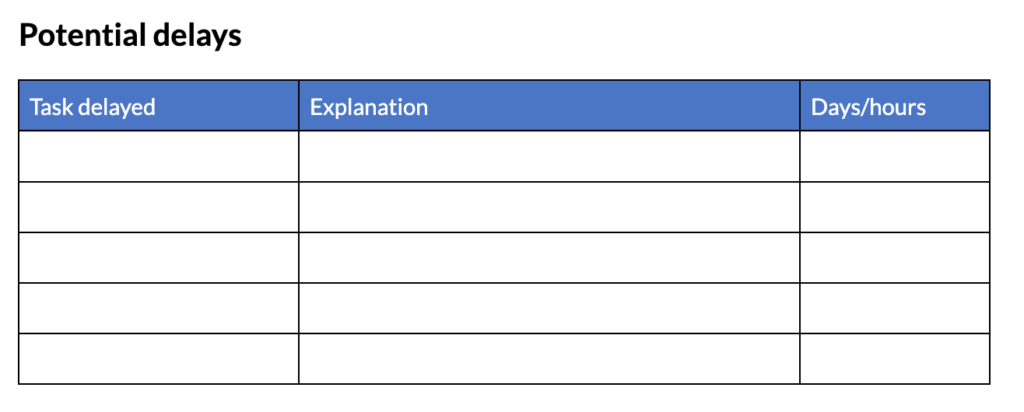
Delays are unavoidable on any construction projects. When something happens that may delay work progress, record it in two sections: the section relevant to the type of task that was delayed, and in this section. For example, the delayed materials delivery above would be recorded in the materials section and in the potential delays section.
Safety details and risks
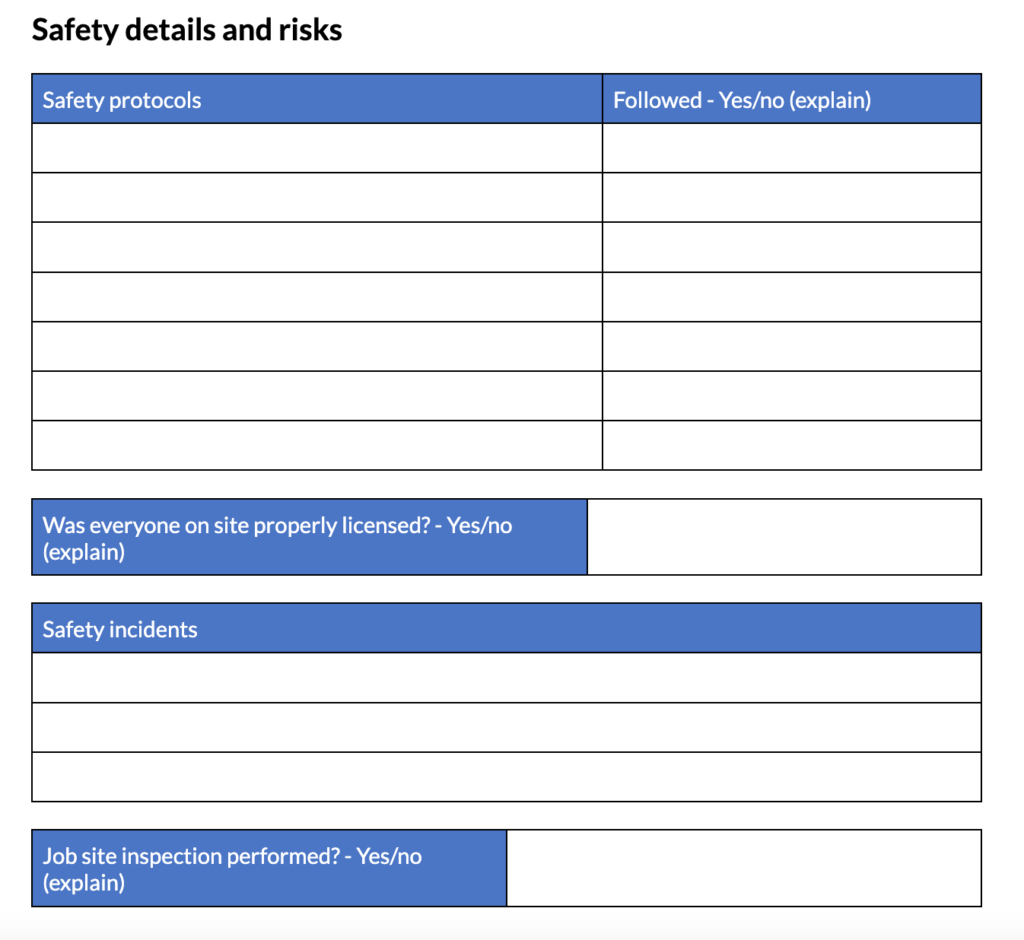
Site safety is a crucial part of your daily report. Daily reporting can be key in protecting you from litigation risk. In the event a dispute arises, detailed reporting can be a powerful tool.
Your report should include a thorough review of any and all safety protocols and whether or not they were followed on site that day, and verification that everyone present on site held the proper licenses to work. It goes without saying, but this section should include the mention of any hazards or safety incidents or accidents that occurred onsite. Also include whether or not a job site inspection was performed that day.
Site visitors
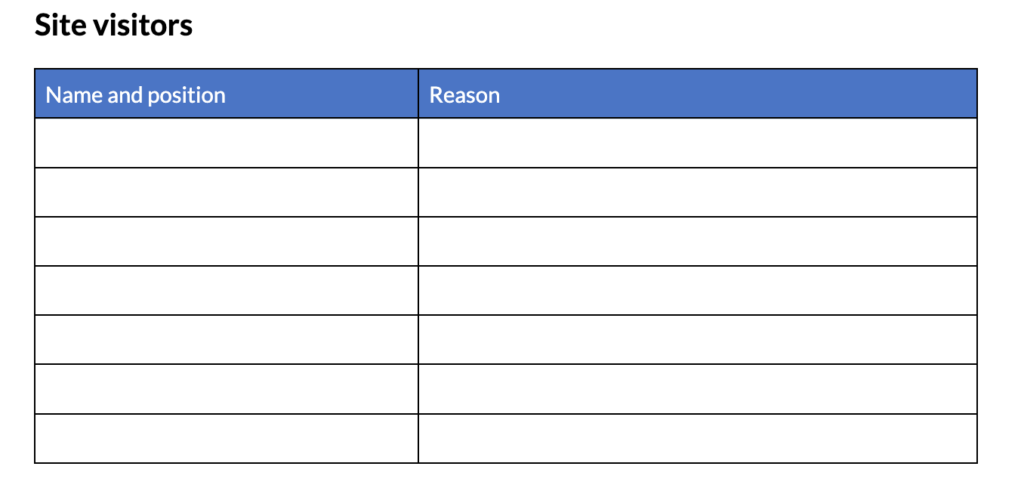
It’s common for people who aren’t crew members or project owners to come to the worksite, whether that be project investors or even worker family members. No matter whom, any visitor to the site should be documented in the daily report.
The ‘notes and commentary’ section — and its importance
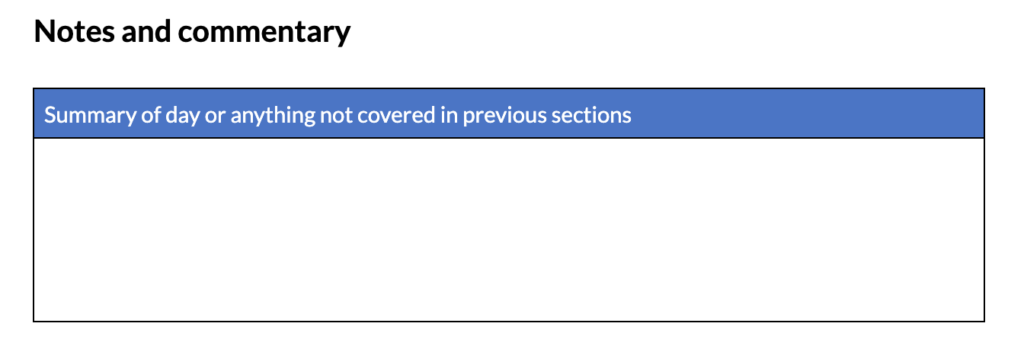
It may seem like an afterthought, but the notes and commentary section is the real bread and butter of these reports. They’re crucial for settling disputes and providing a clear, productive line of communication between the contractors, management team, and other stakeholders.
4 best practices for utilizing daily construction reports
Every job is different, and contractors and construction managers will all have their own way of managing daily construction reports. Still, there are some overarching guidelines that will apply to every job. Keep in mind – these reports are used to inform higher-tiered parties of what’s taking place day-to-day, and the more comfortable they feel with the project, the more quickly they can release payments.
1. Use appropriate detail
First and foremost, the devil is in the details. Fill out your daily reports with sufficient detail to provide a clear picture of the day to day activities. Broad descriptions help no one. These documents are supposed to record everything that happens on the project, not just when things go wrong. If there is a delay or work stoppage, explain in length the reasons for the delay and continue to monitor and record the delays until they are resolved.
2. Send reports on time
The next tip is to file reports as early as possible. Memories are fickle beasts! Sometimes, I can’t remember what I had for lunch yesterday! The shorter time between the actual events and recording them, the more accurate reports will be. Also, it will help gain favor with the GC or project manager who is charged with collecting these reports.
3. Keep it simple
Make sure that reports are simple, clear and concise. Keep in mind that these are also used to keep clients and stakeholders informed, so try not to use specific, technical terms.
Speaking of simplicity, you may want to consider adding a checklist to your reports. Checklists can help reduce mistakes and increase the likelihood of everything being documented. Also, it may be helpful to use a standardized form for all participants on the project. Collecting and organizing these reports can be simplified by using a standardized form.
4. Use technology to make daily construction reports a breeze
Even if daily reports aren’t required on your project, it’s highly recommended that every contractor make it a standard practice. They don’t require that much effort upfront and can save you valuable time and money in case a dispute arises later. Plus, if they’re really an annoyance, designate someone on your team to fill them out!
Better yet – leverage technology. Just like Levelset makes the process of exchanging payment documentation easy, there are companies out there that completely streamline the daily reports process. Procore includes daily logs that automatically record weather conditions and simplify labor tracking as a feature, for example. By leveraging technology, a contractor or sub can completely take the paper out of the equation, and sending the daily report to a customer can be done at the push of a button (or rather, the tap of a screen).
Why are daily construction logs important?
Daily construction reports act as a living record of the project. They tell the full details of the day-to-day progress on site. Daily reports help everyone involved on the job understand the performance, progress, and productivity of a project.
Skipping the daily construction report can pose a number of threats to the overall success of your project. You increase your risk of small issues becoming larger issues because they weren’t spotted or documented early enough. Inexcusable delays, safety concerns – any number of other issues can arise, and if left unattended, they might fester.
Daily reports help foster transparency, communication, and collaboration
One benefit of using daily reports is to identify and reduce project delays. Most unsuccessful projects struggle because there is a lack of collaboration and communication. Depending on the size of the project, there can be numerous different labor crews and contractors and it is tough to maintain a certain level of transparency. Everyone on the project should know who is also on the project and what their roles are. Without daily progress reports, you increase the risk of misunderstandings, mistakes, and ultimately delays. Through proper documentation, you can help keep a project on schedule by identifying any of these delays, issues, or risks that could derail the timeline.
Also, without daily reports, communication between parties can get strained. Other contractors and subs rely on this information, and if an undocumented delay occurs, contractors may be held accountable for delays that were out of their control. Lastly, if you don’t track the progress effectively, you run the risk of not getting paid for any extra work performed. Obviously, using an organized method for change orders is a good idea. But sometimes, changes are made on the fly – and with good reason! By documenting that change in a daily report, a contractor or sub can preserve a snapshot of why, how, and when a decision is made.
Having a solid daily reports procedure in place can also improve your customer relations and improve the perception of your business. Clients and typically uninformed when it comes to the inner-workings of a construction project from start to finish. The ability to demonstrate progress in a clear and easily understandable way can help ease anxiety, which will increase the likelihood of getting paid quickly (more on speeding up payments below).
Daily reports are your ‘proof’ in case of a dispute
The most important aspect of a daily reporting procedure is proof! Disputes concerning payments or amount of work performed arise constantly on construction projects. With a stack of properly executed daily reports, you can potentially clear any issues early, without resorting to more drastic solutions. You will have a full report of labor hours, materials used, supplier delays, weather conditions, and any other aspects of the build. This is particularly helpful if litigation ever arises. Anytime you feel that daily reports are unnecessary or too much hassle, think of the legal and payment recovery implications! That should set you straight.
Sending effective daily construction reports can speed up payment
Can sending effective daily construction reports speed up payment? Yes!
When an owner and contractor know and trust everyone who is on the project, it’s easier to release payments down the chain. This same effect happens when daily notices are properly utilized. These reports tell a story of the project — and telling that story in a detailed and thorough way can reduce any uncertainty preventing higher-tiered stakeholders from releasing payment. Plus, if there is an issue that needs to be addressed – when such an issue is reported quickly and clearly, it can be addressed. Letting a problem fester and hoping it will go unnoticed is not the solution — and it could cause problems for everyone trying to get paid.
Daily reports are about managing risk and maintaining quality, and documentation is the key! There are so many different teams and jobs that need to be performed, and staying on top of all these moving parts can seem like a daunting task. Having a living record of the project’s lifespan can lower unanticipated costs, reduce payment/performance disputes, decrease safety risks, and keep your project on the right track.
But taking a look deeper – daily construction reports promote communication between project stakeholders. They provide a level of transparency that’s sorely needed in this industry. When project stakeholders cooperate and communicate, construction payment disputes become a thing of the past.


